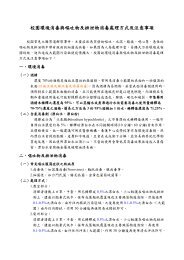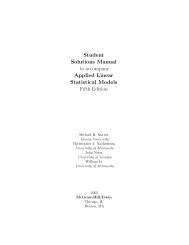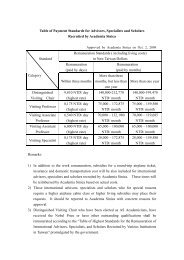Journal of Film Preservation - FIAF
Journal of Film Preservation - FIAF
Journal of Film Preservation - FIAF
Create successful ePaper yourself
Turn your PDF publications into a flip-book with our unique Google optimized e-Paper software.
Treasures IV – American Avant-Garde <strong>Film</strong>,<br />
1947-1986<br />
Paolo Cherchi Usai<br />
DVDs<br />
Traditionnellement projeté en des<br />
lieux dits non-commerciaux, le cinéma<br />
expérimental a été victime de la<br />
domination bien connue du cinéma de<br />
fiction et de sa séance de deux heures.<br />
Mais ce cinéma, qu’on disait marginal,<br />
fait désormais partie de l’histoire et les<br />
films d’avant-garde sont projetés dans<br />
les festivals, les musées et les symposia,<br />
souvent sous forme de compilations (90<br />
minutes de Hollis Frampton, 2 heures<br />
de surréalisme français, etc.), dans un<br />
contexte bien éloigné de celui d’origine<br />
des œuvres en question.<br />
Les responsables du 4 e volume du<br />
National <strong>Film</strong> <strong>Preservation</strong> Foundation<br />
ont à l’évidence été très conscients<br />
de ce défi : loin d’eux la prétention de<br />
nous présenter une histoire syncrétique<br />
du cinéma d’avant-garde américain<br />
(contrairement à la collection Unseen<br />
Cinema parue en 2005); ici le plaisir de<br />
découvrir l’emporte sur l’exhaustivité.<br />
Ainsi plusieurs cinéastes de premier<br />
plan ne sont pas nécessairement<br />
représentés par leurs films les plus<br />
célèbres et il n’y a pas d’ordre strict<br />
(genres, styles, etc.) dans la présentation<br />
des films.<br />
Un autre aspect important de cette<br />
édition est la qualité des textes<br />
de présentation – qui s’adressent<br />
autant au spécialiste qu’au cinéphile<br />
curieux - et leur rapport à chaque film<br />
individuellement. Quel bonheur de lire<br />
ces notes (biographiques, historiques,<br />
esthétiques), puis de plonger dans le<br />
film!<br />
Les 26 films composant le c<strong>of</strong>fret<br />
témoignent du travail de cinq archives<br />
du film : l’Anthology <strong>Film</strong> Archive,<br />
collection majeure pour le cinéma<br />
expérimental aux Etats-Unis, l’Academy<br />
<strong>Film</strong> Archive, le Museum <strong>of</strong> Modern Art,<br />
le Pacific <strong>Film</strong> Archive et le New York<br />
Public Library’s Donnell Media Center.<br />
Enfin la musique d’accompagnement<br />
de John Zorn est en tous points<br />
remarquable, dans sa subtilité autant<br />
que dans sa diversité.<br />
One <strong>of</strong> the great tragedies <strong>of</strong> experimental cinema – aside from its inherent<br />
fragility as a cultural and material entity – is the fact that it has existed<br />
in a world dominated by feature-length film exhibition practice, with a<br />
two-hour slot focused upon a single main attraction. True, avant-garde<br />
films have mostly been screened in non-commercial venues; their proud<br />
marginality from the mainstream circuit is dependent, among other<br />
things, upon an a priori rejection <strong>of</strong> the conventional modes <strong>of</strong> public<br />
presentation. But now that the experiments have become history, they<br />
tend to be displayed in a context (festivals, museums, conferences) that is<br />
pr<strong>of</strong>oundly alien from their original purpose as individual, discrete entities.<br />
In programming terms, this means that avant-garde cinema is <strong>of</strong>ten shown<br />
in the form <strong>of</strong> compilations: 90 minutes <strong>of</strong> Hollis Frampton, two hours <strong>of</strong><br />
French surrealism, an evening with the Structuralists, and so on.<br />
However, these films were rarely meant to be seen as part <strong>of</strong> anthologies<br />
or systematic surveys: you would see Joseph Cornell’s Rose Hobart (1936)<br />
and then do something else, perhaps listen to a poem or to a music<br />
performance. By all accounts, a 120-minute presentation <strong>of</strong> Stan Brakhage<br />
films is a sheer torture for the audience, and an insult to the filmmaker. A<br />
similar kind <strong>of</strong> risk is implicit in the presentation <strong>of</strong> shorts in a DVD set,<br />
not only due to the natural tendency to play them all at once, but also<br />
because <strong>of</strong> the very nature <strong>of</strong> the package, necessarily geared towards<br />
completeness and subject to the predictable logic <strong>of</strong> chronological order.<br />
This premise is necessary to understand the significance <strong>of</strong> the fourth<br />
installment in the National <strong>Film</strong> <strong>Preservation</strong> Foundation’s landmark series<br />
on American cinema. Taken at face value, this elegantly designed 2-disc<br />
sampler does not even attempt to provide a concise history <strong>of</strong> avant-garde<br />
filmmaking in the United States, a far cry from Image Entertainment’s<br />
massive collection Unseen Cinema (2005). An impressive number <strong>of</strong> major<br />
artists are included in Treasures IV, but not necessarily through their major<br />
works; even the styles and tendencies represented by the 26 titles selected<br />
for the occasion are not arranged in a strict order, and they do not cover<br />
the entire spectrum <strong>of</strong> experimental cinema in America in the mid-20th<br />
century. The point is that this seemingly idiosyncratic approach is a blessing<br />
in disguise, as the authors <strong>of</strong> the project – working under the guidance <strong>of</strong><br />
NFPF’s Jeff Lambert, a longtime expert in the field – have achieved what<br />
a good film programmer should always aim at: an exciting roadmap for<br />
intellectual discovery, rather than a complete but unsurprising chart.<br />
An eloquent pro<strong>of</strong> <strong>of</strong> this is the relationship between the individual films<br />
reproduced on DVD and the corresponding program notes. Each title is<br />
treated on its own terms, as a distinctive mirror <strong>of</strong> its era, thus requiring<br />
proper explanation at all levels – archival, historical, aesthetic, biographical.<br />
One <strong>of</strong> the most precious rewards <strong>of</strong> Treasures IV comes from the gradual<br />
process involved in reading an introductory text, getting to know the artist<br />
77 <strong>Journal</strong> <strong>of</strong> <strong>Film</strong> <strong>Preservation</strong> / 81 / 2009
















